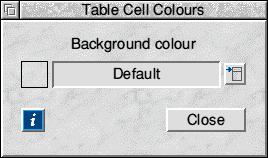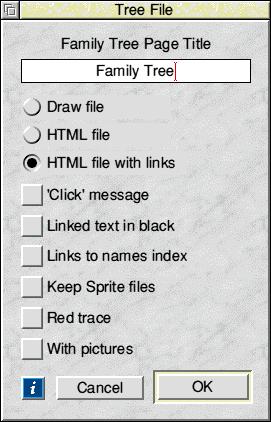A host of new features have been added to WebWonder for version 6.00, many requested by existing users. At the same time the opportunity has been taken to fix bugs and remove anomalies.
Here is a list of the new features:
A new section has been added to the Choices dialogue box to initiate auto save.
When the Auto save switch is off all the other icons are greyed out. The save time can be varied from 1 to 60 minutes.
Once auto save has been activated, modified files will be saved automatically if they have not been saved during the specified time.
The 'With prompt' option allows you to decide whether to save now or delay the save. A Ctrl click on delay will disable the auto save for the page. A page's auto-save may also be disabled or re-enabled through the new File>Autosave page menu option.
On loading a page file, if a table or image is discovered to be wider than the currently chosen page width then the page width will automatically be increased to allow it to be properly viewed. (For tables, an absolute pixel size is required.)
On loading a page file where Cascading Style Sheets are used, the CSS effect display switch is now automatically turned on.
A new option Site>Transfer>Export allows all files marked for upload to be saved in a directory. The marked for upload status in not cleared.
HTML files are handled by your browser. PHP files are handled by the server and allow for greater interaction for the users of your pages. PHP requires a degree of programming and is aimed at the advanced user. You can find out more about PHP at www.w3schools.com/php/php_intro.asp , along with working examples.
You might also like to look at: http://www.guru99.com/what-is-php-first-php-program.html
Media type detection uses one or more PHP files to detect what type of device is being used to view the page. This information can then be used to choose different pages or styles for devices such as iPad, iPhone or Android. (Click here to try it out, but you will have to be viewing this page on one of those devices to see anything other than 'computer' as the device.
'Sunday start' is a new switch that has been added to the Calendar dialogue box. When selected, weeks will start from Sunday, rather than Monday for calendars and the diary pages and also for week numbering.
This new tool opens a dialogue box which is unlike any other in WebWonder. Its appearance is similar to the upper part of other table tools but its behaviour is quite different.

While this box is open, virtually all other operations are suspended and a 'paint pot' pointer appears when the pointer is over a WebWonder page. The box permits a colour to be chosen in the usual way. SEL (left button) dragging the paint pot pointer over table cells will then change them to the selected colour (which could be Default). ADJ (right button) dragging the paint pot pointer over table cells will reset them to Default.
This feature is particularly useful when working with calendars. Wiping the pointer over the required cells can establish closed periods or session prices etc. More than one page may be open and worked on at a time!
The 'New Individual' box has been given a new section towards the bottom for loading a picture. A JPEG file may be dragged from somewhere within the site, usually the 'images 'directory, to the box. The picture will then appear in a reduced form on the new record page, appropriately sized and positioned.
The 'New Couple' option has been added to the Genealogy menu. This simply calls the 'New Individual' box twice but then ensures that the two individuals are married to each other.
This can be particularly useful when one of the individuals is unknown. It ensures that the correct unknown is married to the known. It can often be difficult to identify individual unknowns when trying to marry them manually. Where both parties are known the new Family box described next is usually more appropriate.

This new box available from the site Genealogy menu greatly simplifies the linking of the records for individuals. It also reduces the likelihood of errors or missing links.
Not only can it be used to establish the linked relationships between parents and children but also may be used to verify them or even remove them in case of error. It even handles things like divorce, annullment and adoption.
The site menu's Genealogy>Family test replaces the former Parent test, which produced a report file which listed individuals with only one parent defined.
The new report produces a list of files which would not correctly form a family unit for any of the following reasons:
In the past, the only way to get the names of the people to test into the box was to drag the individuals’ file icons there. Now there are two more ways of achieving this. Firstly, a double-ADJ click on a WebWonder filer icon will load the name of the person; into the top icon if it is empty, otherwise the bottom one. The second way is to use the -index/html file. Open its window in WebWonder and double-ADJ click on a name in the list. Double-ADJ click in such a window selects the line, but in this case, if the relationship box is also open, the name will be passed on as for the double-ADJ click on a filer icon.
In addition to the relationships that the box could already detect, half-cousins can now be detected as well. A sample site is available to download, called MQOS.zip. It contains a portion the the Scottish royal family. Mary Stewart, ‘Queen of Scots’ married Henry Stuart, Lord Darnley, who was also her half-cousin. The free Relations programs for RISC OS and Windows are also available to download, which have been updated to include half-cousins. (See below .)
WebWonder version 5.00 was not able to detect the non-enduring 'step' relations caused by later marriages. These are now detected by version 6.00. To find out more, click here .
Family trees in Draw format have been improved by removing some of the unnecessary dog-legs in the sections below the widest part of the tree. (This is not possible for the HTML versions described below.)
WebWonder creates its family trees by placing the names of the individuals on a regular grid with one row per generation. However, this can lead to a problem if there is more than one line being followed where marriages joining the lines have different numbers of generations between them. In the past, the tree simply broke and the link between the child and its parents was lost. In this version the child’s father is marked as ‘Father of [n]’ and the child is marked with ‘[n]’, where n represents an integer that increases with each case found. This means that the drawn lines never need to cross the generations, only join them.

Two new tree formats are now also supported and a new dialogue box has been provided to select the desired format. Both of the new formats create an HTML file (in other words, a web page) plus a directory full of GIF files. The GIF files are picture files for the lines between the generations. The HTML file in either case consists of a table that holds the names of the individuals as text. For the linked case the text also becomes a link to the records of the individuals themselves. Clicking on such a link in a browser opens the individual’s record in a new window.
The generation of the GIF files depends upon the use of Peter Hartley’s !InterGif program. The latest version of this can be downloaded from:
www.mw-software.com/software/intergif/ig619.zip
InterGif is used to convert temporary Sprite files of each strip of lines into a GIF file.
NB: If !InterGif has not been ‘seen’ by the RISC OS filer, the HTML options will be greyed out.
If you wish to publish the version of the HTML file -tree/html without links, don’t forget to publish the TreeGIFs directory and its contents as well as it is used by that file. The same applies to the ‘with links’ version but in this case, all the files for all the individuals must also be published so they are accessible from the tree file. If pictures have been included, then the TreeJPGs directory will also need to be present.
This format of tree is a simple web page that shows the relationship between the individuals in the conventional way, with husbands usually on the left and in date order, where dates are available. This is as close to the Draw file version as can be reasonably achieved within the constraints of HTML 4.
This format is very similar to the type just described except that the names are now also used as links to the records of the individuals. In other words, simply click on a name in the tree to see a person's record with all its additional information.
It is possible to generate a family tree with only one name provided. In this case, turning on the Red trace would show that individual's tree text entry in red. When two names are given, both names are shown in red and if there is a blood relationship between them, the lines for this will also be red.
This feature is available for all three types of tree file.
It has always been possible to include pictures of photographs of individuals in their record pages. Now, however, it is possible to have thumbnails of these shown above the names in the family tree files.
As with the other thumbnail features, the small pictures are created using !ChangeFSI. If this has not been 'seen' by the filer, or there are no pictures available , the 'With pictures' option will be greyed out.
The 'half-cousins' example tree mentioned above shows both pictures and red trace in use.
A new genealogy tutorial file has been provided to take you quickly and easily through the steps required to create your own family web site complete with family tree and pictures.
WebWonder version 6.00 (both upgrade and full version) is now supplied with a bonus copy of !Draw2PDF which will allow Draw format family trees to be converted to PDF. Both WebWonder and Draw2PDF have your traceable serial number embedded in them and so should not be copied to others.
However, two more free programs are included that may be freely shared. These are RISC OS and Windows versions of the same program which provides the functionality of the Genealogy>Relationships dialogue box so that others can examine your family data. Click here to learn more and try them out.
In previous versions of WebWonder, only the first four of the appendices of the manual were available in the electronic version. From version 6.00, the only part not supported in the electronic version is the index as this is largely replaced by the fully linked contents page.
The sharp increase in the production and postage costs of the printed manual has led to it being offered as an optional extra rather than part of the package for both upgrades and full versions. Accordingly the price of the full version has been reduced.